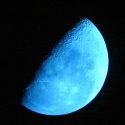We’ve heard about terraforming the Moon and Mars as we attempt to colonize space, but what about Venus? Could we live here one day?
How different would it be from life on Earth? Believe it or not, Earth and Venus are very similar. At times, Venus is even referred to as Earth’s “sister planet.”
They’re both roughly the same size, have the same mass, same gravity and are both made out of the same material: a central iron core and a rocky mantle. Unfortunately, the comparisons end there. Unlike Earth, Venus is extremely hot, has an incredibly dense atmosphere and toxic fumes on its surface.
What would we need to do to make it habitable? Scientists and astronomers have been theorizing how to terraform Venus for over half a century.
The two biggest issues that need to be solved are the atmosphere, and the temperature on Venus. Currently the surface of Venus is a sweltering 462 degrees sign C (864 degrees sign F), hot enough to melt lead.
And the atmosphere, made up mostly of carbon dioxide, is 93 times as heavy as Earth’s. One proposed way of altering Venus’ atmosphere is to bomb it with hydrogen.
Hydrogen bombs, when reacting with the carbon dioxide in the atmosphere, would create graphite and water. This would fall to the planet’s surface and cover 80% of it with oceans. Mind you, they wouldn’t be nearly as deep as Earth’s oceans. Venus would only have 10% the amount of water that Earth has.
This would take a lot of hydrogen. The only way we could get enough is if we were to harvest the resource from Jupiter or Saturn.
This approach would also require iron aerosol, a material that can be mined from asteroids. If all went according to plan, the dense carbon dioxide atmosphere would be reduced to being just three times as heavy as Earth’s. This would also help clear the clouds of sulfuric acid that hang over the planet.
Okay, the atmosphere is clear. Now, what about the temperature?
One way to cool the surface is with solar shades. A series of small spaceships, or one large lens, that would divert the rays of the Sun. These solar shades could be placed on the surface of the planet or in the atmosphere, slowly working to cool down the planet, and reduce radiation, another issue that would need to be resolved before we started living on Venus.
In addition to solar shades, NASA thinks we could build floating cities above the clouds of Venus. These would work as a safe living space, as we learn and attempt to terraform the environment.
To cool the planet even more, and speed up the process, cooling pipes could be put on the surface of the planet. These pipes would take heat from the surface and bring it up to colder parts of the atmosphere.
Now, we have a suitable atmosphere, a proper temperature, and clean air but there’s one other huge issue that humans might have if they moved to Venus. They’d have extremely long days and nights since.
Venus rotates once every 243 Earth days. Meaning a day on Venus is 5,800 hours long. Not to mention, it’s the only planet in our Solar System to rotate clockwise, meaning that its extremely slow sunrise would happen in the west, and sunsets would be in the east.
We could create the illusion of a 24-hour day cycle by using massive mirrors and having them rotate to reflect the Sun. If all this managed to work correctly, Venus would feel just like home, with maybe just a touch less gravity.
After all this, Venus would finally be habitable. Sure the planet would rotate differently, and you’d get a different view of the sun, but it could be another place for humans to live. Scientists theorize it could be a “backup” planet one day.
Studying more about Venus could teach us something about Earth. Venus suffers incredibly strong greenhouse effects, the cause of its extreme temperatures and dense atmosphere.
Subscribe to What-If on Youtube or follow the show on Facebook Watch.
Sources
- “How Do We Terraform Venus? – Universe Today”. Williams, Matt, 2016. Universe Today. Accessed December 17 2018.
- “What Are The Lagrange Points? – Universe Today”. Cain, Fraser, 2016. Universe Today. Accessed December 17 2018.
- “Terraforming Of Venus”. 2018. en.wikipedia.org. Accessed December 17 2018.
- “Can We Terraform The Planet Venus?”. 2018. Youtube. Accessed December 17 2018.
- “WHAT IF WE COULD TERRAFORM VENUS”. 2018. Youtube. Accessed December 17 2018.
- “Slate’S Use Of Your Data”. 2013. Slate Magazine. Accessed December 17 2018.
- “What Is A Terrestrial Planet? – Universe Today”. Williams, Matt, 2015. Universe Today. Accessed December 17 2018.



























